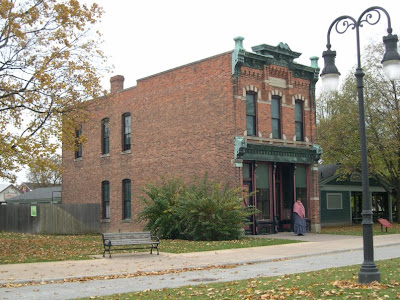Luther Burbank Birthplace (now known as the Burbank Store)
 Luther Burbank, famed horticulturalist (see Luther Burbank Office, to read of his work) was born in this circa 1800 house originally located in Lancaster, Massachusetts in 1849. He was the son of a farmer and maker of brick and pottery. He attended the district school until he was 15 and then spent four winters at the Lancaster Academy. Most of his scientific education, however, was obtained from reading at the public library in Lancaster. According to his own account, his reading of Charles Darwin's Variation of Animals and Plants under Domestication in 1868 proved the turning point in his career, causing him to take the production of new species and varieties of plants as his life's work.
Luther Burbank, famed horticulturalist (see Luther Burbank Office, to read of his work) was born in this circa 1800 house originally located in Lancaster, Massachusetts in 1849. He was the son of a farmer and maker of brick and pottery. He attended the district school until he was 15 and then spent four winters at the Lancaster Academy. Most of his scientific education, however, was obtained from reading at the public library in Lancaster. According to his own account, his reading of Charles Darwin's Variation of Animals and Plants under Domestication in 1868 proved the turning point in his career, causing him to take the production of new species and varieties of plants as his life's work.In 1870, 2 years after the death of his father, Burbank used his inheritance to help purchase a tract of 17 acres near the small town of Lunenburg, where he took up the business of market gardening. Here he produced his first "creation," the Burbank potato, and began the work that was to make him famous.
Despite his success as a market gardener, in 1875 Burbank decided to sell his land and move to California, where his three older brothers had already moved. He settled in Santa Rosa, where he would carry on his work for the next 50 years.He died in 1926.
Re-discovered in 1936, architect Ed Cutler and about 50 boys from the famed Wayside Inn schools dismantled Burbank's birthplace during that fall and winter. Interestingly, a later owner of the house split the frame structure in half and constructed a brick building in the middle. Ford bought only the two original wings.
By early summer of 1937, the Burbank House, now put back together as it once was, had found a new home in Greenfield Village.
For years, the seven room Burbank home was portrayed as it was during the time he lived there, and even included the original cradle that Luther's father made for him at his birth. Unfortunately, in recent years, the Village management decided to turn this historic home into a souvenir shop, selling knick-knacks and the like. Hopefully, one day they will return it to it's former glory. (I have no photos of the way it looked before the "store" changeover, I'm sad to say, and I will spare you photographs of the current inside look).
One need only to eye the Noah Webster Home directly across the street from Burbank's for historical presentation done well.
.



Comments